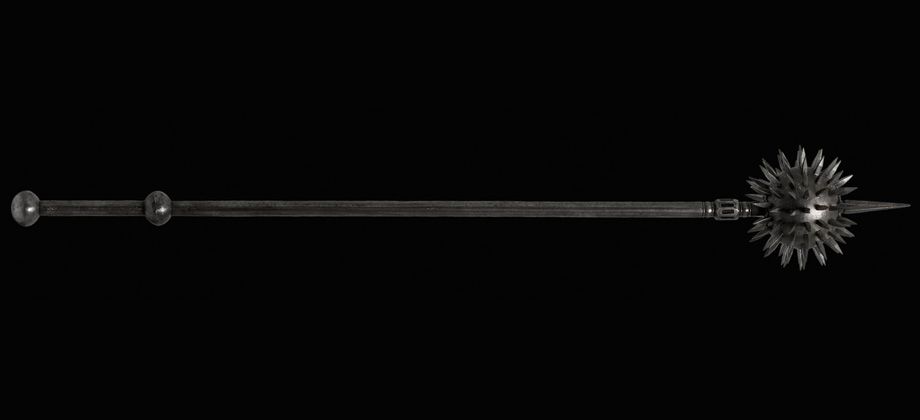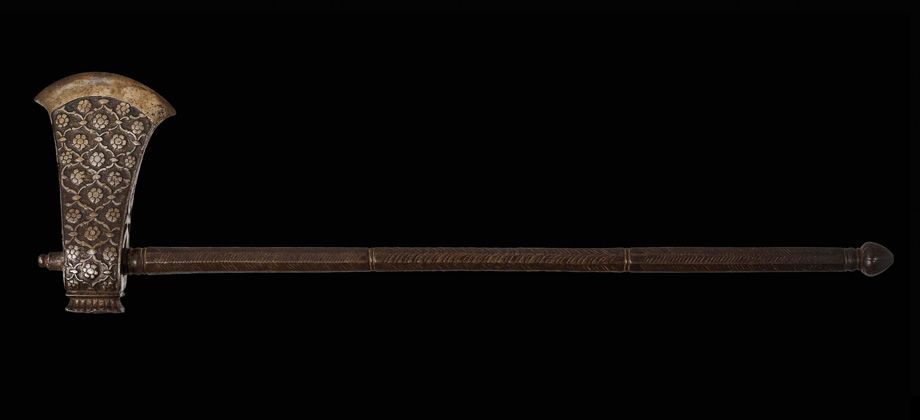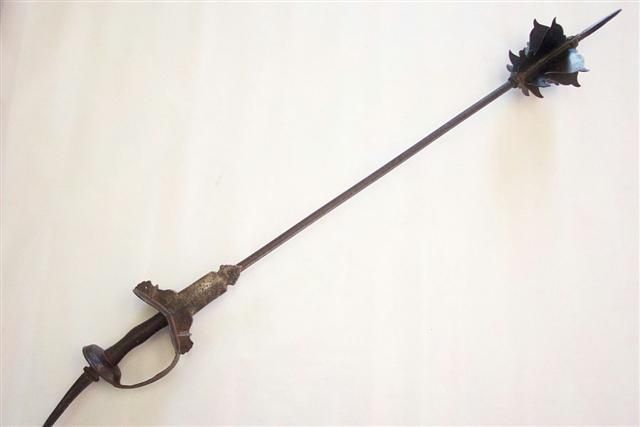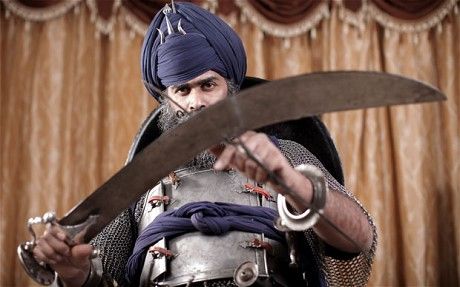
Sikh Arms & Armour
- pistolero
- One of Us (Nirvana)

- Posts: 421
- Joined: Wed May 06, 2009 4:43 pm
- Location: Dubai
- pistolero
- One of Us (Nirvana)

- Posts: 421
- Joined: Wed May 06, 2009 4:43 pm
- Location: Dubai
- pistolero
- One of Us (Nirvana)

- Posts: 421
- Joined: Wed May 06, 2009 4:43 pm
- Location: Dubai
Re: Sikh Arms & Armour
Talwar
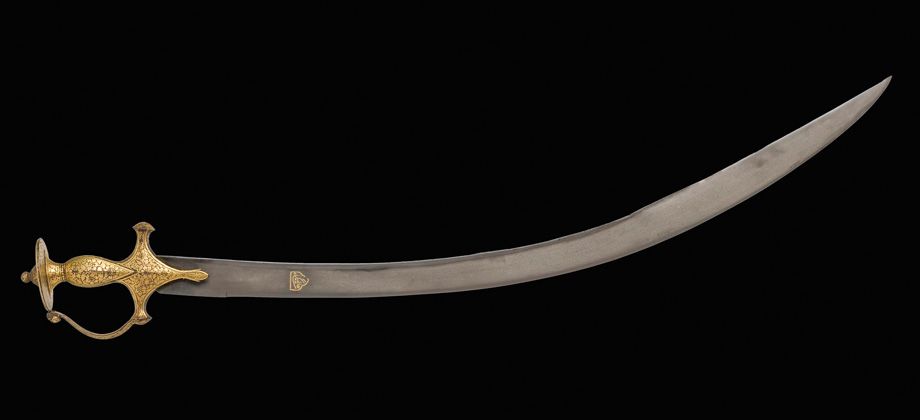
Sosunpatta
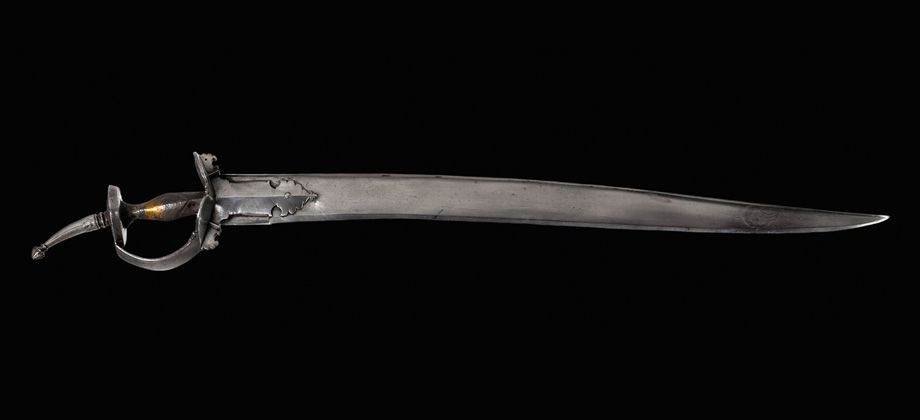
Char Aina & Bazu Band
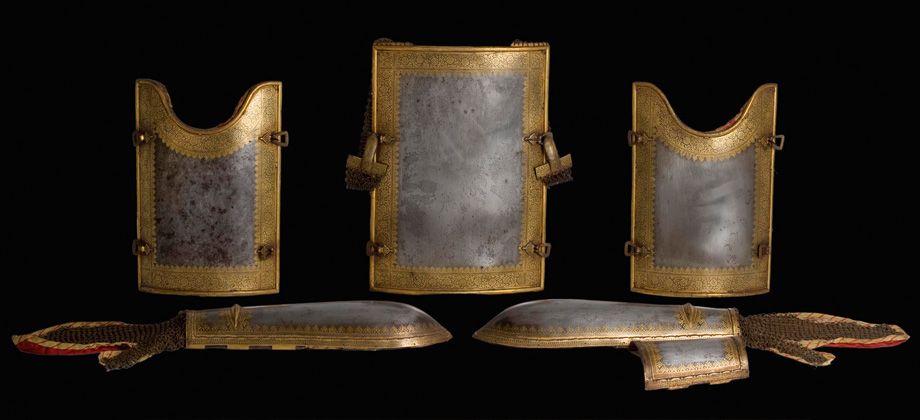

Sosunpatta

Char Aina & Bazu Band

"Whatever is begun in anger ends in shame."
- pistolero
- One of Us (Nirvana)

- Posts: 421
- Joined: Wed May 06, 2009 4:43 pm
- Location: Dubai
Re: Sikh Arms & Armour
Battle Axe: (Indo Persian, but known to be used by the Nihang's)


"Whatever is begun in anger ends in shame."
- pistolero
- One of Us (Nirvana)

- Posts: 421
- Joined: Wed May 06, 2009 4:43 pm
- Location: Dubai
-
Katana
- Veteran

- Posts: 1004
- Joined: Mon Jan 25, 2010 12:22 pm
- Location: Gujarat
Re: Sikh Arms & Armour
Pistolero,
This has been a long time coming! A rather endemic weapon of the Sikhs is missing from your inventory! . I just don't seem to recall the name but it was a long flexible sword like coil of steel and was wielded to keep attackers at bay over a specified distance.
. I just don't seem to recall the name but it was a long flexible sword like coil of steel and was wielded to keep attackers at bay over a specified distance.
The chakram or quoit is the quintessential Sikh weapon. The Sikh Light Infantry in the Indian Army still wear them on ceremonial occasions.http://ja.wikipedia.org/wiki/%E3%83%95% ... iment.jpeg Gen. V.P. Malik, Cheif of Army Staff during the Kargil Conflict, belonged to this regiment.
The Rajputs call the quoit Sudarshan.
This has been a long time coming! A rather endemic weapon of the Sikhs is missing from your inventory!
The chakram or quoit is the quintessential Sikh weapon. The Sikh Light Infantry in the Indian Army still wear them on ceremonial occasions.http://ja.wikipedia.org/wiki/%E3%83%95% ... iment.jpeg Gen. V.P. Malik, Cheif of Army Staff during the Kargil Conflict, belonged to this regiment.
The Rajputs call the quoit Sudarshan.
Justice alone is the mainstay of government and the source of prosperity to the governed, injustice is the most pernicious of things; it saps the foundations of the government and brings ruin upon the realm - Sher Shah Sur, Sultan-ul-Adil.
- pistolero
- One of Us (Nirvana)

- Posts: 421
- Joined: Wed May 06, 2009 4:43 pm
- Location: Dubai
Re: Sikh Arms & Armour
Moving ahead it is my attempt to post videos and images of the Chakkars/Chakram
A lot has been seen and heard about the weapon, and im hoping that with participation from all of you we will learn more about this Truly unique Weapon, which has been mentioned in Indian Folklore right from the times of the Mahabharat, to the battle fields of Northern & Western India, where they were extensively used by the Nihangs.
Chakkars to my mind were a Mid Range Weapon, and also as explained earlier used by the Nihangs in their head gear, for close quarter combat, as you will see in the Video & Images ahead, Chakkars were in different sizes and had a multitude of applications. Which made it a Versatile Weapon on the battlefield.
Starting with an Image below of Nihang Infantry, displaying the Chakram:

As you can see each man is carrying several on his person and of different sizes. In the Turban itself several Chakrams, the size of "Kada's" were inserted to act as armor.
The following is a Discovery Channel Video from the "weapons masters" which will allow us to understand the Chakram in greater detail:
The Chakram could be used in many ways, normally it was twirled in the Forefinger and then hurled towards the target, the othe way was the "Chutki" where it was held between Forefinger and Thumb and hurled sideways or even straight.
Following are some exampled of stance & throwing chakars:

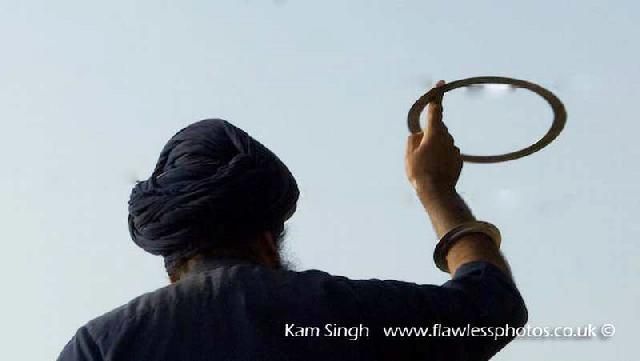
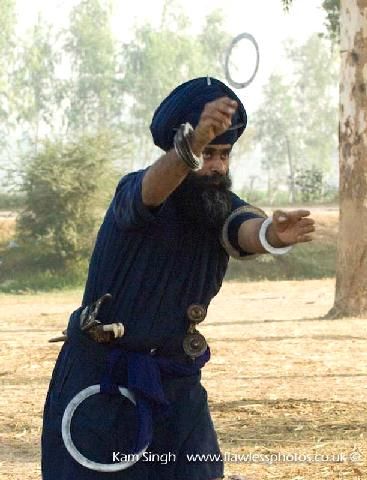
A lot has been seen and heard about the weapon, and im hoping that with participation from all of you we will learn more about this Truly unique Weapon, which has been mentioned in Indian Folklore right from the times of the Mahabharat, to the battle fields of Northern & Western India, where they were extensively used by the Nihangs.
Chakkars to my mind were a Mid Range Weapon, and also as explained earlier used by the Nihangs in their head gear, for close quarter combat, as you will see in the Video & Images ahead, Chakkars were in different sizes and had a multitude of applications. Which made it a Versatile Weapon on the battlefield.
Starting with an Image below of Nihang Infantry, displaying the Chakram:

As you can see each man is carrying several on his person and of different sizes. In the Turban itself several Chakrams, the size of "Kada's" were inserted to act as armor.
The following is a Discovery Channel Video from the "weapons masters" which will allow us to understand the Chakram in greater detail:
The Chakram could be used in many ways, normally it was twirled in the Forefinger and then hurled towards the target, the othe way was the "Chutki" where it was held between Forefinger and Thumb and hurled sideways or even straight.
Following are some exampled of stance & throwing chakars:



"Whatever is begun in anger ends in shame."
- pistolero
- One of Us (Nirvana)

- Posts: 421
- Joined: Wed May 06, 2009 4:43 pm
- Location: Dubai
Re: Sikh Arms & Armour
Katanaji,
I had just started putting together the post in Chakar's by the time you posted
Anyway I have posted some stuff, and Im adding 2 more photos Chakar's in my possession soon
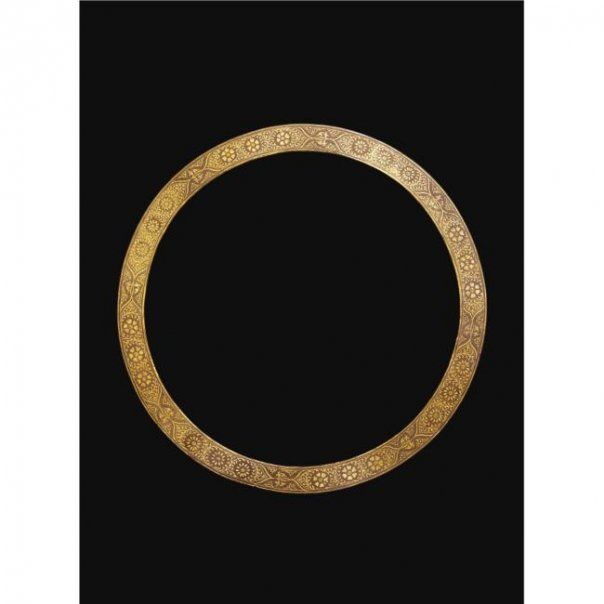
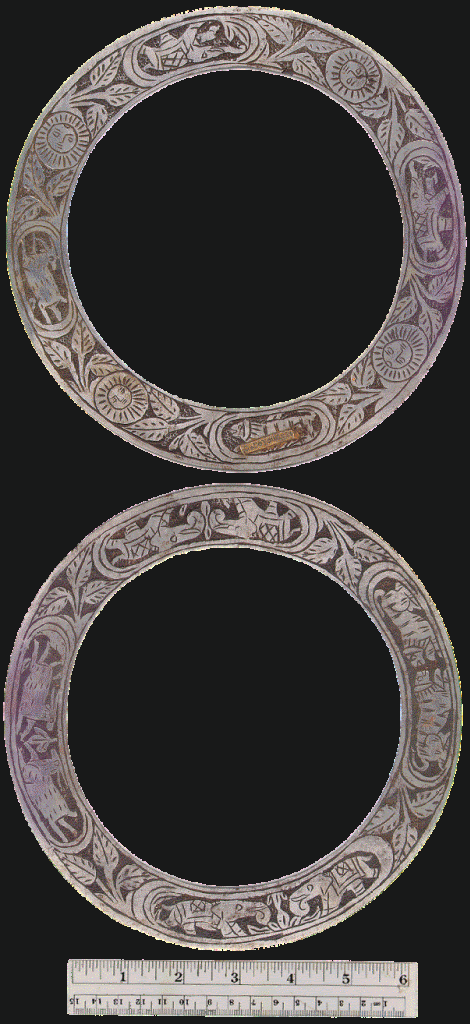
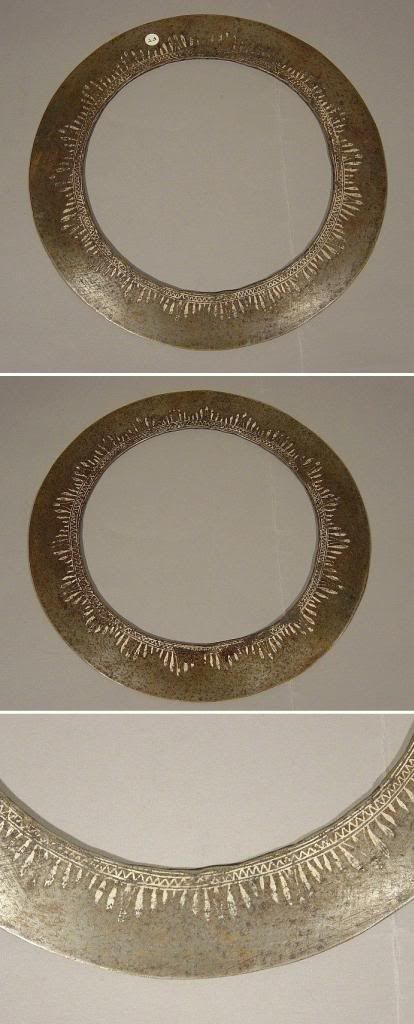
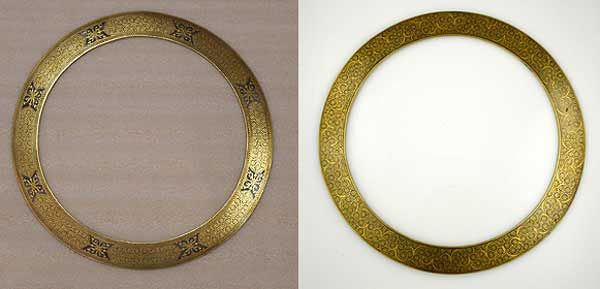
I had just started putting together the post in Chakar's by the time you posted
Anyway I have posted some stuff, and Im adding 2 more photos Chakar's in my possession soon




"Whatever is begun in anger ends in shame."
- pistolero
- One of Us (Nirvana)

- Posts: 421
- Joined: Wed May 06, 2009 4:43 pm
- Location: Dubai
Re: Sikh Arms & Armour
Katanaji,
The Flexible Sword you are referring to is the URUMI or something similar to the URUMI, honestly in all the arms I have collected so far, I have never come across this weapon as northern Indian weapon.
True it was used in the Ultimate Warrior TV series and was demonstrated by a Nihang, and I have seen it used in Gatka many times, Im still not sure it is a Sikh Weapon. (Even used by Shahrukh Khan in Ashoka )
)
It would help if some members on the forum can shed light on this subject, as the Urumi in my mind is classic Kalari
It could be referred to as the Nagini Sword, but that too are the swords with Wavy blades, similar to the Kris, and not even close the Urumi.
Do advise, if in the Rajput armoury there is any similar weapon?
Would love to learn more.
Look forward to hearing from you all.
Regards,
Pistolero
The Flexible Sword you are referring to is the URUMI or something similar to the URUMI, honestly in all the arms I have collected so far, I have never come across this weapon as northern Indian weapon.
True it was used in the Ultimate Warrior TV series and was demonstrated by a Nihang, and I have seen it used in Gatka many times, Im still not sure it is a Sikh Weapon. (Even used by Shahrukh Khan in Ashoka
It would help if some members on the forum can shed light on this subject, as the Urumi in my mind is classic Kalari
It could be referred to as the Nagini Sword, but that too are the swords with Wavy blades, similar to the Kris, and not even close the Urumi.
Do advise, if in the Rajput armoury there is any similar weapon?
Would love to learn more.
Look forward to hearing from you all.
Regards,
Pistolero
"Whatever is begun in anger ends in shame."
-
Katana
- Veteran

- Posts: 1004
- Joined: Mon Jan 25, 2010 12:22 pm
- Location: Gujarat
Re: Sikh Arms & Armour
The Chakram/ Sudarshan was very much a Rajput weapon. However, , just like the bow and arrow, it fell out of favour with the coming of the Turko-Persian-Afghan forces whom they had to face. Two battle tactics relegated it to the backburner of the Rajput armouries. One, mounted warfare. It lost it's application when the Rajputs took to cavalry tactics extensively. Second, gunpowder and firearms. The on-off relationship of the Rajputs with the Mughals had no place for the sudarshan, largely due to extensive usage of armour by both forces. I have seen some faulad sudarshans with my mother's family but they are not ornamented in any fashion whatsoever.
The flexible sword that I was referring to is very much like the Urumi but has a different name. Just can't remember it. Quite true that it is used in the Gatka.
The Asi, despite it's name leading to some confusion, is the flexible sword of the Rajputs. My family has one and the tip of the blade can be bent till the hilt. If shaken, it quivers like a leaf or like a shaving blade. These were extremely light swords that could be wielded by women or the infirm. The stories that I heard from oldies was that it could be wielded by just the thumb and a single finger. Obviously it was not a battlefield weapon.
The flexible sword that I was referring to is very much like the Urumi but has a different name. Just can't remember it. Quite true that it is used in the Gatka.
The Asi, despite it's name leading to some confusion, is the flexible sword of the Rajputs. My family has one and the tip of the blade can be bent till the hilt. If shaken, it quivers like a leaf or like a shaving blade. These were extremely light swords that could be wielded by women or the infirm. The stories that I heard from oldies was that it could be wielded by just the thumb and a single finger. Obviously it was not a battlefield weapon.
Justice alone is the mainstay of government and the source of prosperity to the governed, injustice is the most pernicious of things; it saps the foundations of the government and brings ruin upon the realm - Sher Shah Sur, Sultan-ul-Adil.
- Moin.
- Poster of the Month - Sep '11 & Apr '13

- Posts: 1718
- Joined: Fri May 07, 2010 11:10 am
- Location: Gujrat
Re: Sikh Arms & Armour
Excellent post again pistolero. Is there an edged weapon that is unique to Sikhism or the Nihang Martial culture. All these edged weapons, including the Chakram are or derivatives of Indo Persian Edged Weapons. But then again it is fairly new and had little time for it to evolve and by then fire arms had already come into the picture.
Great pics BTW and I'll reiterate excellent post. Will go to some cybercafe and see the video you posted.
Katanaji; what is the difference between the Jhaji and the Asi Sword. Most of the Talwars that I see with the Nihangs are the large Teha Type of Blades, any specific reason for these finding favour apart from the obvious fact of people in that region being of a bigger built and physique compared to the rest of the country.
Best
Moin.
Great pics BTW and I'll reiterate excellent post. Will go to some cybercafe and see the video you posted.
Katanaji; what is the difference between the Jhaji and the Asi Sword. Most of the Talwars that I see with the Nihangs are the large Teha Type of Blades, any specific reason for these finding favour apart from the obvious fact of people in that region being of a bigger built and physique compared to the rest of the country.
Best
Moin.
In the depth of winter, I finally learned that within me there lay an invincible summer. Camus
- airgun_novice
- Veteran

- Posts: 1138
- Joined: Sun Sep 12, 2010 11:15 pm
- Location: Mumbai-Thane, India
Re: Sikh Arms & Armour
The flexible "belt" sword is known as "daanD-patta" or only "patta" in Maharashtra region.
A bit OT -> Shivaji was a great exponent of this weapon. However, It's famous (or notorious) in history as the one that almost got Shivaji.
When Shivaji went off to meet Afzal Khan at the foot of Pratapgadh, Khan's bodyguard, Sayyed Banda, who was known as an expert of this patta tried to cut off Shivaji's head. However quick thinking by Jiva Mahala, an expert in the patta himself, saw another lightning strike that severed Sayyed's wrist. Hence the saying - "hotaa Jivaa mhaNoon waachalaa Shiva" - roughly translated - because of JIva - was saved Shiva.
Some akhadas in Kolhapur still teach its use. Another great exponent and teacher till recent times was one "Dada Palkar" - descendant of "prati Shivaji" - Netaji Palkar - who taught in Parel region of Mumbai to a chosen few. He died at a ripe old age of about 95; his only lament that interest in usage of traditional weapons is fast disappearing since it took considerable mastery of sword to move on to the flexible one and the youth seldom showed keen interest or dedication. Dada Palkar had a cameo in a children's film - (forgot the name) where in he wielded two swords or a sword and a patta.
Sorry for the detour - back to the SIkh Arm & Armour.
A bit OT -> Shivaji was a great exponent of this weapon. However, It's famous (or notorious) in history as the one that almost got Shivaji.
When Shivaji went off to meet Afzal Khan at the foot of Pratapgadh, Khan's bodyguard, Sayyed Banda, who was known as an expert of this patta tried to cut off Shivaji's head. However quick thinking by Jiva Mahala, an expert in the patta himself, saw another lightning strike that severed Sayyed's wrist. Hence the saying - "hotaa Jivaa mhaNoon waachalaa Shiva" - roughly translated - because of JIva - was saved Shiva.
Some akhadas in Kolhapur still teach its use. Another great exponent and teacher till recent times was one "Dada Palkar" - descendant of "prati Shivaji" - Netaji Palkar - who taught in Parel region of Mumbai to a chosen few. He died at a ripe old age of about 95; his only lament that interest in usage of traditional weapons is fast disappearing since it took considerable mastery of sword to move on to the flexible one and the youth seldom showed keen interest or dedication. Dada Palkar had a cameo in a children's film - (forgot the name) where in he wielded two swords or a sword and a patta.
Sorry for the detour - back to the SIkh Arm & Armour.
- Moin.
- Poster of the Month - Sep '11 & Apr '13

- Posts: 1718
- Joined: Fri May 07, 2010 11:10 am
- Location: Gujrat
Re: Sikh Arms & Armour
airgun_novice wrote:The flexible "belt" sword is known as "daanD-patta" or only "patta" in Maharashtra region.
A bit OT -> Shivaji was a great exponent of this weapon. However, It's famous (or notorious) in history as the one that almost got Shivaji.
When Shivaji went off to meet Afzal Khan at the foot of Pratapgadh, Khan's bodyguard, Sayyed Banda, who was known as an expert of this patta tried to cut off Shivaji's head. However quick thinking by Jiva Mahala, an expert in the patta himself, saw another lightning strike that severed Sayyed's wrist. Hence the saying - "hotaa Jivaa mhaNoon waachalaa Shiva" - roughly translated - because of JIva - was saved Shiva.
Some akhadas in Kolhapur still teach its use. Another great exponent and teacher till recent times was one "Dada Palkar" - descendant of "prati Shivaji" - Netaji Palkar - who taught in Parel region of Mumbai to a chosen few. He died at a ripe old age of about 95; his only lament that interest in usage of traditional weapons is fast disappearing since it took considerable mastery of sword to move on to the flexible one and the youth seldom showed keen interest or dedication. Dada Palkar had a cameo in a children's film - (forgot the name) where in he wielded two swords or a sword and a patta.
Sorry for the detour - back to the SIkh Arm & Armour.
AGN, are you sure of this. Pata or Dand Pata is referred to the gauntlet sword which has a protective metal covering on the entire arm and was the traditional weapon of the Maratha warrior (lots in display at the Prince of Wales Museum). The flexible belt like blade is URUMI used in Kalaripayat (not sure if the spelling is right).
Regards
Moin.
In the depth of winter, I finally learned that within me there lay an invincible summer. Camus
- xl_target
- Old Timer

- Posts: 3488
- Joined: Wed Jul 29, 2009 7:47 am
- Location: USA
Re: Sikh Arms & Armour
What a great thread guys!
Very informative and enjoyable.
Very informative and enjoyable.
“Never give in, never give in, never; never; never; never – in nothing, great or small, large or petty – never give in except to convictions of honor and good sense” — Winston Churchill, Oct 29, 1941
- airgun_novice
- Veteran

- Posts: 1138
- Joined: Sun Sep 12, 2010 11:15 pm
- Location: Mumbai-Thane, India
Re: Sikh Arms & Armour
The patta has a single blade fixed at the hilt. It' still is flexible and could be folded around the waist with the glove sticking out. It had a metal sleeve or glove into which the arm (for right handed swordsman it was the left since the right held the sword) could be slipped into. BTW, I always had the Qn on how the joint (between the glove and the blade) was created.
The urumi has at least two and sometimes more (and thinner) blades and is more flexible plus is usually coiled and tied. The hilt is "open" and thus can be nicely hidden within the cumberband.
The coiled state of both releases the potential energy added with the element of surprise. Now one of the versions of urumi has a rotating blade set (since we consider the hilt to be fixed in hand) at the hilt and requires even greater skill than "regular" urumi and is also rarely taught at kalaris; usually to one or two exceptionally skilled students who have potential to be Masters (gurukkul) themselves.
The slightly "stiffer" nature plus the radius (arm + say 5-6') of the patta would have posed a problem while using it on horseback or in tight infantry unit. So probably it was also less used even in those times - hence so few "experts". I would say its usage would have been restricted to rarified (entrenched) formation v/s more tightly formed (and numerous) enemy unit - thus one would have to be one's own backup in a situation where say 5-6 people would surround. The patta could then be used to "allow" in the fight zone circle, one or two attackers at a time for swordfight.
Patta was thus a supplement weapon to the sword - either khanda or talwar and if you chose to wield it, you lost out on usage of the shield. Urumi was a stand alone weapon and had the shield as a defensive weapon/ guard to support it. Plus a (sword+shield) combo is good for infantry, cavalry on flat or in mountainous terrain while (urumi+shield) is good for flat open ground where attackers are far less in numbers and can spread out. Due to its over-flexible nature the urumi would have to be used in stooped (bent at knees) posture while the patta could also be used standing/ jumping or with exceptional skill on horseback. The danD-patta like the tiger claws would best be (usually) used in duels, practice or demonstrations.
My thinking - so I could be wrong up here.
During Shivaji-Afzal meet only 4-6 people were inside the huge shamiana. Shivaji, Afzal, Sayyed, Jiva Mahala and the two 'vakils'. Afzal's army was outside at some distance while Shivaji's 'Mawalas' were nicely hidden in forest. Only 8-10 bodyguards of each were waiting outside the shamiana in the immediate vicinity. So while Shivaji was Sayyed's target, as was pre-planned (remember Sayyed's reputation with the patta was wide spread), Sayyed was Jiva's target from the start. Afzal Khan was always marked out by Shivaji. Shivaji was one of the few leaders who actually led from the front in the battles he participated in, rather than direct from afar. Hence the nomination of Netaji Palkar as his succcessor, if Afzal Khan had managed to kill him. May be in preparation, Sayyed was standing right next to Afzal Khan initially and Shivaji actually had to ask the Khan to re-position him. Jiva also "moved away" in deference to the wishes and thus positioned himself if Sayyed tried his skills. Interestingly enough historians have noted this movement of personal bodyguards and the exchange.
Couple of points to be noted -
1. Afzal Khan had tried similar modus operandi with another king (forgot his name). Plus his rape & slaughter of innocent civilians and intolerance towards all the temples he came across (including birth-place of Bhakti Movement (Pandharpur), Shivaji's Kul-daiwat (Tulza Bhawani), the Mahaganaapti temple of Wai, selection of Sayyed as his bodyguard and his initial position etc. all point out to Khan's intentions. Incidentally, Afzal Khan had no problem with the temple at Wai during his Subhedari there. He did publicly vow to kill Shivaji at the Adilshahi court before he set out. Hence the claim of treachery by Shivaji as was perpetrated by one Adilshahi historian is without merit.
2. Shivaji did not technically kill the Khan. Khan's head was cut off by another of Shivaji's bodyguards stationed outside - Sambhaji Kavji - as the wounded Khan tried to escape. Sayyed's patta did take a knick at Shivaji's head - but again Shivaji was protected by the iron skull cap inside his "feta"(OK ok - not sure of the name here, but a typical turban associated with Shivaji). Jiva already in motion dispatched off both Sayyed and then the Khan's vakil. Shows us the importance of HELMET.
Moin you are right - there are a couple of dand-pattas with wagh-nakhs (tiger claws) which are at display at PoW (now Jijamata) museum but they are kept straightened out for ease of display. Do not really reveal their flexible nature. May be the patta also folded inside the gauntlet, but then it would have to be very flexible.
But as we understand, Shivaji had worn his armor inside his shirt and had wagh-nakhs and the bichwa concealed inside the cumberband since Afzal Khan's directive was that he should come in un-armed. Wearing a gauntlet in the open would have given the precautions away at the start. Only after Khan's failed attempt to stab Shivaji in the back with his khanjar (due to the armor), Shivaji used the tiger claws to inflict wounds and got himself released from the Khan's one arm choke around the neck (almost blacking him out) and then used the bichwa to stab open Afzal Khan's tummy. Afzal Khan was one of the strongest persons known then and had reputation of bending crow-bars or lifting small canons at darbar demonstrations.
Again - my apologies for going OT with the story of the Maharaj, but felt it was relevant here and actually 'revolved' around the danD-patta.
The urumi has at least two and sometimes more (and thinner) blades and is more flexible plus is usually coiled and tied. The hilt is "open" and thus can be nicely hidden within the cumberband.
The coiled state of both releases the potential energy added with the element of surprise. Now one of the versions of urumi has a rotating blade set (since we consider the hilt to be fixed in hand) at the hilt and requires even greater skill than "regular" urumi and is also rarely taught at kalaris; usually to one or two exceptionally skilled students who have potential to be Masters (gurukkul) themselves.
The slightly "stiffer" nature plus the radius (arm + say 5-6') of the patta would have posed a problem while using it on horseback or in tight infantry unit. So probably it was also less used even in those times - hence so few "experts". I would say its usage would have been restricted to rarified (entrenched) formation v/s more tightly formed (and numerous) enemy unit - thus one would have to be one's own backup in a situation where say 5-6 people would surround. The patta could then be used to "allow" in the fight zone circle, one or two attackers at a time for swordfight.
Patta was thus a supplement weapon to the sword - either khanda or talwar and if you chose to wield it, you lost out on usage of the shield. Urumi was a stand alone weapon and had the shield as a defensive weapon/ guard to support it. Plus a (sword+shield) combo is good for infantry, cavalry on flat or in mountainous terrain while (urumi+shield) is good for flat open ground where attackers are far less in numbers and can spread out. Due to its over-flexible nature the urumi would have to be used in stooped (bent at knees) posture while the patta could also be used standing/ jumping or with exceptional skill on horseback. The danD-patta like the tiger claws would best be (usually) used in duels, practice or demonstrations.
My thinking - so I could be wrong up here.
During Shivaji-Afzal meet only 4-6 people were inside the huge shamiana. Shivaji, Afzal, Sayyed, Jiva Mahala and the two 'vakils'. Afzal's army was outside at some distance while Shivaji's 'Mawalas' were nicely hidden in forest. Only 8-10 bodyguards of each were waiting outside the shamiana in the immediate vicinity. So while Shivaji was Sayyed's target, as was pre-planned (remember Sayyed's reputation with the patta was wide spread), Sayyed was Jiva's target from the start. Afzal Khan was always marked out by Shivaji. Shivaji was one of the few leaders who actually led from the front in the battles he participated in, rather than direct from afar. Hence the nomination of Netaji Palkar as his succcessor, if Afzal Khan had managed to kill him. May be in preparation, Sayyed was standing right next to Afzal Khan initially and Shivaji actually had to ask the Khan to re-position him. Jiva also "moved away" in deference to the wishes and thus positioned himself if Sayyed tried his skills. Interestingly enough historians have noted this movement of personal bodyguards and the exchange.
Couple of points to be noted -
1. Afzal Khan had tried similar modus operandi with another king (forgot his name). Plus his rape & slaughter of innocent civilians and intolerance towards all the temples he came across (including birth-place of Bhakti Movement (Pandharpur), Shivaji's Kul-daiwat (Tulza Bhawani), the Mahaganaapti temple of Wai, selection of Sayyed as his bodyguard and his initial position etc. all point out to Khan's intentions. Incidentally, Afzal Khan had no problem with the temple at Wai during his Subhedari there. He did publicly vow to kill Shivaji at the Adilshahi court before he set out. Hence the claim of treachery by Shivaji as was perpetrated by one Adilshahi historian is without merit.
2. Shivaji did not technically kill the Khan. Khan's head was cut off by another of Shivaji's bodyguards stationed outside - Sambhaji Kavji - as the wounded Khan tried to escape. Sayyed's patta did take a knick at Shivaji's head - but again Shivaji was protected by the iron skull cap inside his "feta"(OK ok - not sure of the name here, but a typical turban associated with Shivaji). Jiva already in motion dispatched off both Sayyed and then the Khan's vakil. Shows us the importance of HELMET.
Moin you are right - there are a couple of dand-pattas with wagh-nakhs (tiger claws) which are at display at PoW (now Jijamata) museum but they are kept straightened out for ease of display. Do not really reveal their flexible nature. May be the patta also folded inside the gauntlet, but then it would have to be very flexible.
But as we understand, Shivaji had worn his armor inside his shirt and had wagh-nakhs and the bichwa concealed inside the cumberband since Afzal Khan's directive was that he should come in un-armed. Wearing a gauntlet in the open would have given the precautions away at the start. Only after Khan's failed attempt to stab Shivaji in the back with his khanjar (due to the armor), Shivaji used the tiger claws to inflict wounds and got himself released from the Khan's one arm choke around the neck (almost blacking him out) and then used the bichwa to stab open Afzal Khan's tummy. Afzal Khan was one of the strongest persons known then and had reputation of bending crow-bars or lifting small canons at darbar demonstrations.
Again - my apologies for going OT with the story of the Maharaj, but felt it was relevant here and actually 'revolved' around the danD-patta.




